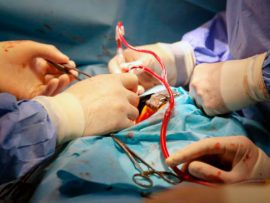Abstract Objective Congenital heart disease affects 1% of US births, with many babies requiring major cardiothoracic surgery under cardiopulmonary bypass (CPB), exposing the more critical patients to neurodevelopmental impairment. Optimal..
Read MoreAbstract We conducted a high-risk redo mitral valve replacement through a right mini-thoracotomy without rib spreading (redo-MICS MVR) under systemic hyperkalemia combined with circulatory arrest to circumvent complications associated with..
Read MoreAbstract Sternal reentry for repair of aortic pseudoaneurysms poses a unique technical challenge to prevent exsanguination. Initiation of peripheral cardiopulmonary bypass and deep hypothermic circulatory arrest prior to reentry are..
Read MoreAbstract Introduction: Adequate cerebral protection for aortic reoperation is challenging and optimal technique is still controversial. Case Report: We report a hybrid cannulation approach to achieve safe cerebral protection..
Read MoreAbstract Background Aortic aneurysms involving the proximal aortic arch, which require hemiarch-type repair, typically require circulatory arrest with antegrade cerebral perfusion. Left carotid antegrade cerebral perfusion (LCP) via distal arch..
Read MoreAbstract Background Selective antegrade cerebral perfusion (SACP) is adopted as an alternative to deep hypothermic circulatory arrest (DHCA) during aortic arch surgery. However, there is still no preclinical evidence to..
Read MoreAbstract Background Cerebral circulatory arrest times >40 minutes during have previously been shown to be associated with increased morbidity and mortality. The purpose of this study was to redefine what would..
Read MoreAbstract Objective Currently, there is no risk scores built to predict risk in thoracic aortic surgery. This study aims to develop and internally validate a risk prediction score for patients..
Read MoreAbstract OBJECTIVES The aim of this retrospective multicentre study was to investigate and compare clinical outcomes of unilateral and bilateral antegrade cerebral perfusion (ACP) strategies on cerebral protection during..
Read MoreAbstract Objective The present study is to describe the clinical impact of S100 and S100β for the evaluation of cerebral damage in cardiac surgery with or without the use of..
Read MoreAbstract Objective Little is known about the outcomes of operations that involve inducing hypothermic circulatory arrest for relatively extensive proximal . We attempted to identify predictors of postoperative hospital length of stay..
Read MoreAbstract Background Moderate (MHCA) versus deep (DHCA) hypothermia for circulatory arrest in has been purported to reduce and bleeding complications, although there are limited data supporting this claim. This study aimed to..
Read MoreAbstract OBJECTIVES Organ protective management during aortic arch surgery comprises deep hypothermic (18°C) circulatory arrest (DHCA), or moderate hypothermia (28°C/ ‘tepid’) with regional cerebral perfusion (TRCP). The aim of this..
Read More







